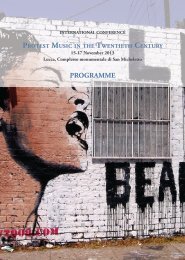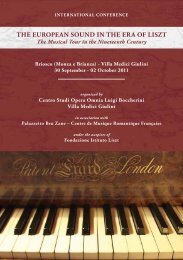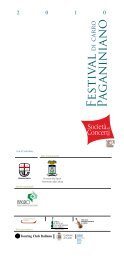Programma - Provincia di Lucca
Programma - Provincia di Lucca
Programma - Provincia di Lucca
You also want an ePaper? Increase the reach of your titles
YUMPU automatically turns print PDFs into web optimized ePapers that Google loves.
works by Boccherini, Haydn and Beethoven stand out, quantitatively as well as qualitatively. Mysecond aim will be to demonstrate the connection between the reception of these works in Corunna,in the private sphere of the urban elite of the Restoration, and within a broader international context.I will take as the basis of my <strong>di</strong>scussion the latest contributions of the historian William Weber onthe musical practices related to the repertoire of the “quartet concert”, mainly using the approachesproposed by Weber regar<strong>di</strong>ng the musical life of Paris. Finally, it should be noted that, to this day,there is no specific study of the chamber music that was received and consumed in Spain during the1820’s. This report presents new data and approaches related to the topic and, more specifically, tothe reception of Boccherini in Spain.• Tim S. Pack (University of Oregon):Music and Narrative in Boccherini’s La Confederazione dei Sabini con Roma and GiuseppericonosciutoLuigi Boccherini remains among the most prolific composers of chamber music; having written morethan fifty trios, ninety quartets, around 125 quintets, and several sextets and <strong>di</strong>vertimenti, he producedmore works in this genre than Joseph Haydn. Over the last twenty years, scholarship on Boccherini’schamber music has sharply increased, and the composer is finally beginning to receive the recognition andappreciation he deserves. However, several areas of his œuvre are still greatly in need of further study. Hisvocal music, which comprises a very small yet significant fraction of his output, remains almost entirelyunknown and inaccessible. In the area of sacred vocal music, Boccherini composed just over a dozen works,inclu<strong>di</strong>ng a Mass, three Mass movements, two psalms, two oratorios (Gioas and Giuseppe riconsciuto), aChristmas cantata, and a setting of Stabat mater. Both the Mass and the cantata are lost, and many ofthe other works have yet to be e<strong>di</strong>ted. His secular vocal music comprises around twenty works, most ofwhich are based on libretti by Pietro Metastasio (1698-1782); also included are a few works for stage andthe political cantata La Confederazione dei Sabini con Roma. Boccherini wrote many of his vocal workseither near the beginning of his career or near the end. Gioas re <strong>di</strong> Giuda, Giuseppe riconsciuto, and LaConfederazione dei Sabini con Roma were written in his early twenties (before 1767), whereas the Massand Christmas cantata were composed around 1800. The second version of his Stabat mater also datesfrom the end of his career (1800). Since there has been at least some scholarship on the Stabat mater,my presentation will focus on two of Boccherini’s early vocal works: the oratorio Giuseppe riconsciuto andthe political cantata La Confederazione dei Sabini con Roma. I will examine how Boccherini varies andmanipulates tempos, textures, dynamics, structures, and harmony to convey musically the narrative andaffect of the text; I will also <strong>di</strong>scuss how these musical elements create unity and momentum and inso doing articulate formal and structural <strong>di</strong>visions throughout the works. My essay will offer analyticalobservations situated in historical and stylistic context and uncover new information about these works,their importance in Boccherini’s output, and their influence on other pieces by him.• Rudolf Rasch (Utrecht University):The Art of Repetition, as Practiced by Luigi Boccherini in his Sonatas Opus 5Repetition is a very common aspect of nearly all Western musical genres, but in no era hasrepetition become so prominent in musical structure as in the Classical Era. Among Classicaleracomposers, the output of Luigi Boccherini can be singled out as one in which repetition ispositively omnipresent. Repetition is present on many levels, from the single bar (or even thesingle beat) to the entire movement, and it manifests itself in many <strong>di</strong>fferent guises: literal, varied,transformed, and so on. Despite its prominence in such contexts, repetition has been stu<strong>di</strong>edvery little so far. In my paper I will propose a classification of the various types of repetition and









